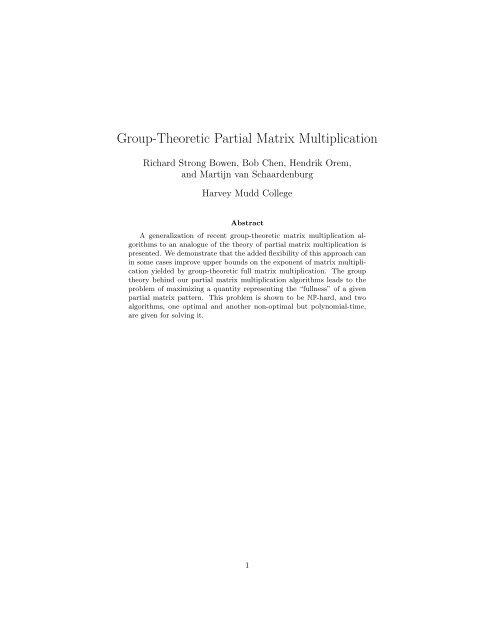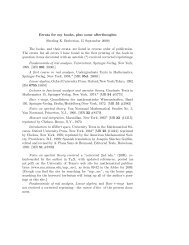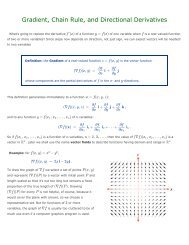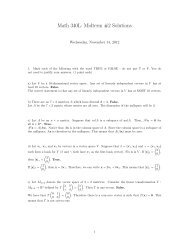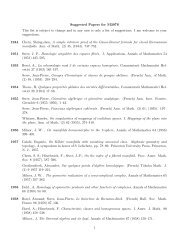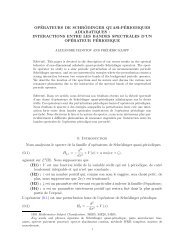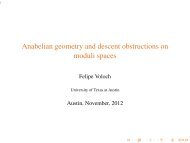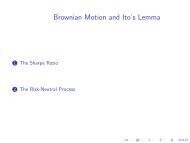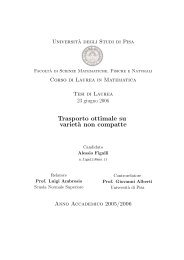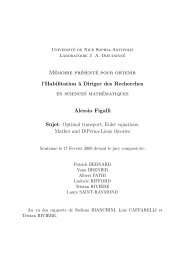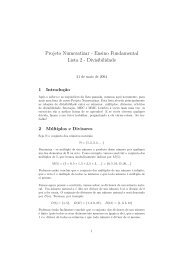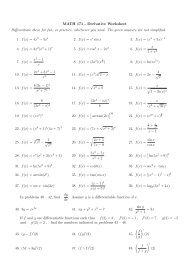Group-Theoretic Partial Matrix Multiplication - Department of ...
Group-Theoretic Partial Matrix Multiplication - Department of ...
Group-Theoretic Partial Matrix Multiplication - Department of ...
You also want an ePaper? Increase the reach of your titles
YUMPU automatically turns print PDFs into web optimized ePapers that Google loves.
<strong>Group</strong>-<strong>Theoretic</strong> <strong>Partial</strong> <strong>Matrix</strong> <strong>Multiplication</strong><br />
Richard Strong Bowen, Bob Chen, Hendrik Orem,<br />
and Martijn van Schaardenburg<br />
Harvey Mudd College<br />
Abstract<br />
A generalization <strong>of</strong> recent group-theoretic matrix multiplication algorithms<br />
to an analogue <strong>of</strong> the theory <strong>of</strong> partial matrix multiplication is<br />
presented. We demonstrate that the added flexibility <strong>of</strong> this approach can<br />
in some cases improve upper bounds on the exponent <strong>of</strong> matrix multiplication<br />
yielded by group-theoretic full matrix multiplication. The group<br />
theory behind our partial matrix multiplication algorithms leads to the<br />
problem <strong>of</strong> maximizing a quantity representing the “fullness” <strong>of</strong> a given<br />
partial matrix pattern. This problem is shown to be NP-hard, and two<br />
algorithms, one optimal and another non-optimal but polynomial-time,<br />
are given for solving it.<br />
1
Contents<br />
1 Introduction 3<br />
2 Full and <strong>Partial</strong> <strong>Group</strong>-<strong>Theoretic</strong> <strong>Matrix</strong> <strong>Multiplication</strong> 4<br />
2.1 Full <strong>Multiplication</strong>: The Cohn-Umans Algorithm . . . . . . . . . 4<br />
2.2 <strong>Partial</strong> <strong>Multiplication</strong>: Aliasing . . . . . . . . . . . . . . . . . . . 5<br />
3 Algorithms for Aliasing Structure 9<br />
3.1 A Polynomial-Time Non-Optimal Algorithm for Finding Aliasing<br />
Covers . . . . . . . . . . . . . . . . . . . . . . . . . . . . . . . . . 9<br />
3.2 Computing the Optimal Cover for Aliasing . . . . . . . . . . . . 9<br />
4 Improving a <strong>Group</strong>-<strong>Theoretic</strong> Construction through Aliasing 10<br />
4.1 The Original Construction . . . . . . . . . . . . . . . . . . . . . . 10<br />
4.2 Relaxing the Triple Product Property . . . . . . . . . . . . . . . 10<br />
5 The Complexity <strong>of</strong> Computing a Best Cover 11<br />
6 Conclusion 13<br />
7 Acknowledgements 13<br />
2
1 Introduction<br />
In 1969, Volker Strassen showed that the naïve algorithm for square matrix<br />
multiplication, which takes O(n 3 ) time to multiply matrices <strong>of</strong> dimension n, is<br />
not optimal [8]; the algorithm he presented multiplied matrices in O(n log 2 7 ) ≈<br />
O(n 2.807 ). Together with the simple lower bound <strong>of</strong> O(n 2 ) on the number <strong>of</strong><br />
multiplications needed to multiply n × n matrices, Strassen’s result originated<br />
the problem <strong>of</strong> determining the “best possible” exponent <strong>of</strong> matrix multiplication.<br />
To be precise, if M(n) is the number <strong>of</strong> field operations in characteristic<br />
0 required to multiply two n × n matrices, Strassen made the first step towards<br />
determining<br />
ω = inf{r ∈ R|M(n) = O(n r )},<br />
the exponent <strong>of</strong> matrix multiplication.<br />
Gradual improvements were made to the upper bound on ω. In 1990, Coppersmith<br />
and Winograd [4] showed that ω < 2.38, a bound which remains the<br />
world record. A promising group-theoretic approach was presented by Cohn<br />
and Umans in 2003 [3]. They described an embedding <strong>of</strong> matrices into a group<br />
algebra that would allow for fast convolution via a Fourier transform, in much<br />
the same way that polynomials can be multiplied efficiently by embedding them<br />
in a group algebra, applying an FFT and then performing the convolution in<br />
the frequency domain. The challenge was to find an appropriate group together<br />
with three subsets which serve to index the matrix entries in the embedding.<br />
Using this method, Cohn et al. [2] tied the record <strong>of</strong> ω < 2.38.<br />
Proving a tight upper bound on ω is a long-standing open problem in theoretical<br />
computer science. It is widely believed that ω = 2, but no progress has<br />
been made on the best known upper bound in nearly two decades.<br />
In this paper, we generalize the results <strong>of</strong> Cohn et al., which only deal with<br />
full matrix multiplication, to a theory <strong>of</strong> group-theoretic partial matrix multiplication<br />
and use this approach to prove bounds on ω. In particular, Theorem 2.12<br />
states that<br />
3 log (i<br />
ω ≤ dωi )<br />
,<br />
log f(A)<br />
where the di are the character degrees <strong>of</strong> the chosen group and f(A) represents,<br />
roughly, the amount <strong>of</strong> information computed in the product <strong>of</strong> two partial<br />
matrices <strong>of</strong> a particular “pattern.”<br />
The group-theory behind our partial matrix multiplication algorithm leads<br />
to an additional computational challenge, namely optimizing the quantity f(A)<br />
given a set <strong>of</strong> possible patterns. We show this problem to be NP-hard, and describe<br />
a non-optimal but polynomial-time algorithm, as well as an exponentialtime<br />
algorithm for solving it. In a particular case, we show how to improve<br />
an upper bound on ω obtained in [2] by using the greater generality <strong>of</strong> grouptheoretic<br />
partial matrix multiplication.<br />
3
2 Full and <strong>Partial</strong> <strong>Group</strong>-<strong>Theoretic</strong> <strong>Matrix</strong> <strong>Multiplication</strong><br />
Our main theorems describe an algorithm for multiplying matrices using triples<br />
<strong>of</strong> subsets not satisfying the triple product property (see Definition 2.4). Some<br />
entries must be set to zero, and then partial matrix multiplications are performed.<br />
This section introduces the original group-theoretic algorithm by Cohn<br />
and Umans [3], as well as the notion <strong>of</strong> ‘aliasing’, the motivation for our focus<br />
on partial matrix multiplication.<br />
2.1 Full <strong>Multiplication</strong>: The Cohn-Umans Algorithm<br />
Definition 2.1. If S, T, U are ordered subsets <strong>of</strong> a group G, then the Cohn-<br />
Umans algorithm [3] for matrix multiplication computes the product <strong>of</strong> matrices<br />
M and N <strong>of</strong> dimensions |S| × |T | and |T | × |U|, respectively, as follows.<br />
Index the rows <strong>of</strong> M by S−1 , the columns <strong>of</strong> M by T , the rows <strong>of</strong> N by<br />
T −1 , and the columns <strong>of</strong> N by U. Then let fM = <br />
−1<br />
i,j<br />
Mi,jsi tj and fN =<br />
−1<br />
j,k<br />
Nj,ktj uk. Compute fP = fM fN, and assign to Pi,k the coefficient <strong>of</strong><br />
s −1<br />
i uk in fP .<br />
Theorem 2.2. The Cohn-Umans algorithm computes, in position i, k <strong>of</strong> the<br />
product matrix, the sum <strong>of</strong> all terms Mi ′ ,jNj ′ ,k ′, where<br />
s −1<br />
i<br />
′ tjt −1<br />
i uk.<br />
j ′ uk ′ = s−1<br />
Pro<strong>of</strong>. Every term in fP is a product <strong>of</strong> a term in fM with a term in fN. The<br />
s −1<br />
i uk term is exactly the sum <strong>of</strong> all terms (zm)(z ′ n), where z, z ′ ∈ C n×n ,<br />
m ∈ S −1 T and n ∈ T −1 U, and mn = s −1<br />
i uk. But this is exactly the sum in the<br />
statement <strong>of</strong> the theorem. <br />
Corollary 2.3. The Cohn-Umans algorithm is correct if and only if for all<br />
s, s ′ ∈ S, t, t ′ ∈ T, u, u ′ ∈ U, we have that ss ′−1 tt ′−1 uu ′−1 = e implies s =<br />
s ′ , t = t ′ , u = u ′ .<br />
Pro<strong>of</strong>. This result follows from the previous theorem since<br />
s −1<br />
i<br />
′ tjt −1<br />
j ′ uk ′ = s−1 i uk<br />
implies i = i ′ , j = j ′ , u = u ′ , meaning that entry (i, k) <strong>of</strong> the product only<br />
contains terms formed by multiplying entry (i, j) by (j, k) in the left and right<br />
factor matrices, respectively. <br />
Definition 2.4. The property in 2.3 is called the triple product property [3].<br />
Example 2.5. The following sets in D12 = 〈x, y|x 6 = y 2 = 1, xy = yx −1 〉 have<br />
the triple-product property:<br />
S = {1, y}<br />
T = {1, yx 2 , x 3 , xy}<br />
U = {1, yx}<br />
4
Thus, S, T , and U can be used to index the product <strong>of</strong> a full 2 × 4 matrix by a<br />
ful 4 × 2 matrix, with no errors.<br />
In this way, Cohn and Umans reduced the problem <strong>of</strong> proving bounds on ω<br />
to that <strong>of</strong> searching for groups with a good combination <strong>of</strong> character degrees<br />
and subsets satisfying the triple product property. It is, however, unnecessary<br />
to require that the group element index sets produce a fully correct product.<br />
Even when terms in the group algebra multiplication incorrectly appear in an<br />
entry <strong>of</strong> the product matrix due to a violation <strong>of</strong> the triple product property by<br />
our chosen subsets S, T, and U (we call this phenomenon aliasing to emphasize<br />
the analogy to the usual Fourier transform in signal processing), these index<br />
sets will still compute the correct product in the case where one <strong>of</strong> the input<br />
entries contributing to each aliasing term contains a zero.<br />
In the next section, we show how to apply the classical theory <strong>of</strong> partial matrix<br />
multiplication to the group-theoretic framework developed by Cohn et al.<br />
We will present bounds on ω realizable through subsets which may or may not<br />
satisfy the triple product property; in a special case, we can show that our algorithm<br />
yields strictly stronger results than the original Cohn-Umans full matrix<br />
multiplication algorithm. For a specific family <strong>of</strong> constructions satisfying the<br />
triple product property, the associated bound on ω can be improved by adding<br />
a single element to each <strong>of</strong> the sets, described in Section 4. This means that the<br />
additional information computed by increasing the matrix dimensions outwieghs<br />
the information lost due to the partial nature <strong>of</strong> the larger multiplication.<br />
2.2 <strong>Partial</strong> <strong>Multiplication</strong>: Aliasing<br />
Definition 2.6. If S, T, U are subsets <strong>of</strong> a group G, the set <strong>of</strong> all triples<br />
((i, j), (j ′ , k), (i ′ , k ′ )) where<br />
s −1<br />
i tjt −1<br />
j ′ uk = s −1<br />
i<br />
′ uk ′<br />
and i = i ′ , j = j ′ , or k = k ′ is called the set <strong>of</strong> aliasing triples, A.<br />
Aliasing sets can be visualized as sets <strong>of</strong> lines representing the triples as<br />
shown in Figure 1. Each line is broken up into two pieces: the first runs from<br />
the left factor matrix to the right factor matrix and represents which pair <strong>of</strong><br />
input entries combine to produce an incorrect term in the product; the second<br />
runs from the right factor matrix to the product, indicating where the incorrect<br />
term appears.<br />
Definition 2.7. The left aliasing set <strong>of</strong> a set <strong>of</strong> aliasing triples A is<br />
{x : there exist y, z such that (x, y, z) ∈ A} .<br />
The right aliasing set and the product aliasing set are defined analagously. The<br />
left aliasing set is the set <strong>of</strong> indices in the left factor matrix in Figure 1 that are<br />
the endpoints <strong>of</strong> one <strong>of</strong> the lines.<br />
5
Figure 1: A visualization <strong>of</strong> the aliasing set in Example 2.10, where the input<br />
matrices are the left and middle rectangles, and the output is on the right. A<br />
triple ((i, j), (j ′ , k), (i ′ , k ′ )) corresponds to a pair <strong>of</strong> lines from (i, j) in the left<br />
factor matrix to (j ′ , k) in the right, and from (j ′ , k) in the right factor matrix<br />
to (i ′ , k ′ ) in the product; the set <strong>of</strong> all (i, j) which is the start <strong>of</strong> a line in the<br />
diagram is the left aliasing set.<br />
It is impossible to have only one <strong>of</strong> i = i ′ , j = j ′ , k = k ′ (if, for example,<br />
only i = i ′ held, then we would have s −1<br />
i euk = s −1<br />
i ′ uk). Thus, an incorrect term<br />
in the Cohn-Umans algorithm will only occur having at least two <strong>of</strong><br />
1. being in the wrong row given its first multiplicand,<br />
2. being in the wrong column given its second multiplicand, or<br />
3. having its multiplicands coming from different positions in their respective<br />
row and column.<br />
Definition 2.8. Let A be a set <strong>of</strong> aliasing triples for S, T, U ⊆ G. We say that<br />
I and J cover A if I and J are subsets <strong>of</strong> the indices <strong>of</strong> entries <strong>of</strong> a |S| × |T |<br />
and |T | × |U| matrix, respectively, such that for all a in A, either the first entry<br />
<strong>of</strong> a is in I or the second is in J. If M and N are |S| × |T | and |T | × |U| entries<br />
such that for every index i in I, Mi is 0, and similarly for N and J, we say that<br />
M and N realize I and J.<br />
Theorem 2.9. Let G be a group and let S, T, U be indexing sets with aliasing set<br />
A. Let M, N be matrices <strong>of</strong> size |S| × |T |, |T | × |U|, respectively, and let I, J be<br />
subsets <strong>of</strong> the indices that cover A. If M, N realize I, J, then the Cohn-Umans<br />
algorithm correctly computes the partial matrix product MN.<br />
Pro<strong>of</strong>. By Theorem 2.2, the extra terms arise from entries in the input matrices<br />
with indices in the aliasing set A. Thus setting the entries corresponding to<br />
entries <strong>of</strong> I and J to zero sets the coefficient on each incorrect term to zero,<br />
yielding the correct product <strong>of</strong> the partial matrices <strong>of</strong> M, N. <br />
6
Example 2.10. Consider our earlier example in D12, with a change to the last<br />
element <strong>of</strong> T :<br />
This triple has aliasing set<br />
S = {1, y}<br />
T = {1, yx 2 , x 3 , x 4 }<br />
U = {1, yx}.<br />
A = {((2, 4), (3, 2), (1, 1)),<br />
((2, 4), (3, 1), (1, 2)),<br />
((1, 4), (3, 2), (2, 1)),<br />
((1, 4), (3, 1), (2, 2))},<br />
as depicted in Figure 1. The first element <strong>of</strong> A describes the indices in the<br />
product<br />
s −1<br />
2 t 4t −1<br />
3 u 2 = s −1<br />
1 u 1<br />
that erroneously form an extra term in the top left corner <strong>of</strong> the product matrix.<br />
Thus, using these sets, the Cohn-Umans algorithm correctly computes these<br />
types <strong>of</strong> partial matrix multiplication:<br />
<br />
a1,1 a1,2 a1,3<br />
<br />
0<br />
a2,1 a2,2 a2,3 0<br />
a1,1 a1,2 a1,3 a1,4<br />
a2,1 a2,2 a2,3 a2,4<br />
⎡<br />
⎢<br />
× ⎢<br />
⎣<br />
b1,1 b1,2<br />
b2,1 b2,2<br />
b3,1 b3,2<br />
b4,1 b4,2<br />
b4,1 b4,2<br />
⎤<br />
⎥<br />
⎦<br />
⎡ ⎤<br />
b1,1 b1,2<br />
<br />
⎢b2,1<br />
b2,2⎥<br />
× ⎢ ⎥<br />
⎣ 0 0 ⎦ .<br />
The aliasing triples are visually depicted in Figure 1.<br />
We will now introduce a function that will be an integral part <strong>of</strong> our partial<br />
matrix multiplication algorithm. It computes the number <strong>of</strong> ones in a tensor <strong>of</strong><br />
partial matrix multiplication, which intuitively means the amount <strong>of</strong> information<br />
computed by this partial multiplication. Its importance will become clear in the<br />
next theorem.<br />
Definition 2.11. Let A be a set <strong>of</strong> aliasing triples and let I and J cover A.<br />
The function f(I, J) is equal to<br />
<br />
kini,<br />
i<br />
where ki is the number <strong>of</strong> entires in the i th column <strong>of</strong> the left factor matrix<br />
which do not appear in I and ni is the number <strong>of</strong> entries in the i th row <strong>of</strong> the<br />
right factor matrix which do not appear in J. Finally, f(A) is<br />
f(A) = max{f(I, J)|I and J cover A}.<br />
7
The function f is a measure <strong>of</strong> how much computation is being done by a<br />
partial matrix multiplication. Notice that if there is no zeroing in a multiplication<br />
<strong>of</strong> m by n by n by p, then by I and J both empty, f ≥ mnp (and it’s easy<br />
to see that f = mnp). The following theorem is used to derive many <strong>of</strong> our<br />
results; it provides a bound on ω given subsets which need not satisfy the triple<br />
product property. For this pro<strong>of</strong>, it is sufficient to consider only matrices <strong>of</strong><br />
complex numbers. Note that in the special case where the aliasing set is empty<br />
(that is, S, T, U have the triple product property), f(A) = |S||T ||U| and our<br />
bound recovers Theorem 1.8 in [2]. This mimics the pro<strong>of</strong> <strong>of</strong> Theorem 4.1 in [3],<br />
and uses some if its terminology.<br />
Theorem 2.12. Let S, T, U ⊆ G with aliasing triples A, and suppose G has<br />
character degrees {di}. Then<br />
ω ≤<br />
3 log(<br />
i dω i )<br />
log f(A)<br />
Pro<strong>of</strong>. Let t be the tensor <strong>of</strong> partial matrix multiplication corresponding to I, J,<br />
the patterns which maximize f. It is clear that<br />
t ≤ CG ∼ <br />
= 〈di, di, di〉<br />
(similar to Theorem 2.3 in [3]). Then the lth tensor power <strong>of</strong> t satisfies<br />
t l ≤ <br />
〈di1 . . . dil , di1 . . . dil , di1 . . . dil 〉.<br />
i1,...,il<br />
By the definition <strong>of</strong> ω, each 〈di1 . . . dil , di1 . . . dil , di1 . . . dil 〉 has rank at most<br />
C(di1 . . . dil )ω+ε for some C and for all ε. So, taking the rank <strong>of</strong> both sides<br />
gives<br />
R(t) l ≤ C<br />
i<br />
l ω+ε<br />
di ,<br />
from Proposition 15.1 in [1]. Since this is true <strong>of</strong> all ε > 0, it holds for ε = 0 by<br />
continuity:<br />
R(t) l l ω<br />
≤ C di .<br />
Taking l th roots as l → ∞ gives<br />
By Theorem 4.1 in [7]<br />
R(t) ≤ <br />
i<br />
d ω i .<br />
3 log(<br />
ω ≤<br />
log f(A)<br />
8<br />
i dω i )<br />
.
3 Algorithms for Aliasing Structure<br />
In the study <strong>of</strong> aliasing, the following problem comes up: there is a pattern A,<br />
and one wishes to find the value f(A) by trying various I, J. This problem is<br />
NP-hard; this section describes the worst-case exponential-time algorithm we<br />
use to solve it exactly, as well as a polynomial time algorithm used to find a<br />
reasonable solution.<br />
3.1 A Polynomial-Time Non-Optimal Algorithm for Finding<br />
Aliasing Covers<br />
In this section we will give a polynomial-time algorithm for finding covering<br />
sets I, J. This is not an approximation algorithm in the complexity-theoretic<br />
sense; it is merely a “pretty good” algorithm which we found useful in research.<br />
Instead <strong>of</strong> finding the cover which minimizes f, we find the cover which zeros<br />
the fewest entries. Viewing the entries in the factor matrices as vertices in a<br />
bipartite graph, and the pairs in the aliasing set as edges, it is clear that we<br />
desire a minimal vertex cover. By König’s theorem, this is equivalent to finding<br />
a maximum matching (for an excellent explanation <strong>of</strong> the associated algorithm,<br />
see [5]), which can be solved efficiently in bipartite graphs with [6].<br />
3.2 Computing the Optimal Cover for Aliasing<br />
When computing f by exhaustive search, one must choose, for each aliasing<br />
triple, whether to satisfy it by zeroing the left or by zeroing the right. After<br />
each choice, however, one can compute the current value <strong>of</strong> f as if the only<br />
triples in A were those already assigned a zero. Then making further choices<br />
will only lower this value <strong>of</strong> f, so if the computed value is below the already<br />
known best value, the entire search tree can be pruned. In pseudocode,<br />
procedure bestDP(A)<br />
S = new Stack<br />
F = new Frame(A) #meaning that F stores A, the set <strong>of</strong> aliasing<br />
triples; and I and J, the trial patterns, currently empty<br />
bestf = -1<br />
bestfFrame = F<br />
while S is not empty<br />
frame = S.pop()<br />
if every triple in A is covered by frame.I and frame.J and<br />
f(frame.I,frame.J) > bestf then<br />
bestf = f(frame.I,frame.J)<br />
bestfFrame = F<br />
continue<br />
if f(frame.I,frame.J)
frame2 = copy(frame)<br />
frame1.I.append(left entry <strong>of</strong> a)<br />
frame2.J.append(right entry <strong>of</strong> a)<br />
S.push(frame1,frame2)<br />
4 Improving a <strong>Group</strong>-<strong>Theoretic</strong> Construction through<br />
Aliasing<br />
In this section we present an improvement over a construction presented in §2<br />
<strong>of</strong> [2].<br />
4.1 The Original Construction<br />
Let<br />
H = Cn × Cn × Cn,<br />
G = H ≀ S2,<br />
and let Hi < H be the subgroup isomorphic to Cn in the ith coordinate. By z<br />
we mean the generator <strong>of</strong> S2, and by eH we mean the identity element <strong>of</strong> H.<br />
We write elements <strong>of</strong> G as<br />
(a, b)z j<br />
where a, b ∈ H and j = 0 or 1.<br />
Define, for i ∈ 1, 2, 3, the subsets <strong>of</strong> G<br />
Si = {(a, b)z j |a ∈ Hi \ eH, b ∈ Hi+1, j = 0 or 1}<br />
where subscripts are taken mod 3. Finally, we let<br />
S = S1, T = S2, U = S3.<br />
By [2], Lemma 2.1, S, T, U have the triple product property. Note that<br />
and so<br />
|S| = |T | = |U| = 2n(n − 1),<br />
f = 8n 3 (n − 1) 3 .<br />
This construction gives ω ≤ 2.9088 for n = 17.<br />
4.2 Relaxing the Triple Product Property<br />
Let Si be as defined in the previous section, and let<br />
S ′ i = Si ∪ {(eH, eH)}.<br />
Let S ′ = S ′ 1, T ′ = S ′ 2, U ′ = S ′ 3, and let A be the associated aliasing set, shown<br />
graphically in Figure 2.<br />
We find that A can be partitioned into three easily analyzed categories:<br />
10
(a) “Bottom aliasing” occurs in the rows <strong>of</strong> the product which are not indexed<br />
by the identity. All aliasing <strong>of</strong> this type can be covered by zeroing some<br />
(n − 1) 2 entries in the (eH, eH) column <strong>of</strong> R.<br />
(b) “Top-Easy aliasing” occurs in the (eH, eH) row <strong>of</strong> the product. These are<br />
entirely covered by zeroing (n − 1) 2 entries <strong>of</strong> the (eH, eH) column <strong>of</strong> L.<br />
(c) “Top-Hard aliasing” also occurs in the (eH, eH) row <strong>of</strong> the product. The<br />
distinction is in the manner in which they arise. Alasing in this category can<br />
be covered by two things: the same entries which cover Top-Easy aliasing,<br />
combined with an additional 2n(n − 1) entries in the (eH, eH) column <strong>of</strong> R.<br />
This decomposition is depicted in Figure 3.<br />
There exists a pair I, J with (n − 1) 2 elements in the first column in L, and<br />
the entire first column in R, that cover A. Thus<br />
f ≥ (2n(n − 1)) 3 + (2n(n − 1)) 2 + (2n(n − 1)) 2n(n − 1) − (n − 1) 2 + 1 ,<br />
which is strictly greater than f for S, T, U. For n = 17, we acheive ω ≤ 2.9084.<br />
The insight here is that we only zeroed entries that we added. That is, this<br />
partial matrix multiplication contains the entire matrix multiplication indexed<br />
by S, T, U, and then some more. Thus, by relaxing the restriction on S, T, U,<br />
we strictly increased the amount <strong>of</strong> computation done, without increasing the<br />
work necessary (since G is constant).<br />
5 The Complexity <strong>of</strong> Computing a Best Cover<br />
Often we are confronted with this problem: given some triple <strong>of</strong> subsets, find<br />
the best way to put aliasing in the factor matrices and have the best bound on<br />
ω, i.e., the best f(I, J). We show this problem is computationally hard.<br />
Consider the problem PARTIAL-TENSOR-ONES: given the dimensions <strong>of</strong><br />
two matrices m, n, p, a set <strong>of</strong> pairs A = {((ai, bi), (ci, di))}, and an integer k,<br />
are there I and J realizing A such that f(I, J) = k? (This is the problem<br />
Figure 2: A visualization <strong>of</strong> the aliasing in the construction introduced in Section<br />
4.2. In this case, n = 2.<br />
11
(a) Bottom Aliasing<br />
(b) Top-Easy Aliasing<br />
(c) Top-Hard Aliasing<br />
Figure 3: A visualization <strong>of</strong> the three types <strong>of</strong> aliasing in the construction given<br />
in Section 4.2.<br />
<strong>of</strong> maximizing the dot product when all the aliasing is to be taken care <strong>of</strong><br />
by the left and right matrices). We show that PARTIAL-TENSOR-ONES is<br />
NP-complete via a reduction from INDEPENDENT-SET, a well-known NPcomplete<br />
problem.<br />
Theorem 5.1. PARTIAL-TENSOR-ONES is NP-complete<br />
Pro<strong>of</strong>. An instance <strong>of</strong> INDEPENDENT-SET consists <strong>of</strong> (some encoding <strong>of</strong>) a<br />
graph and an integer k. Let G = (V, E) be this graph. We will generate an<br />
instance <strong>of</strong> PARTIAL-TENSOR-ONES. Let m = p = |V | and n = 1. For each<br />
edge (vi, vj), add constraints <strong>of</strong> the form ((1, i), (j, 1)) and ((j, 1), (1, i)).<br />
Suppose there is an independent set <strong>of</strong> size k. Then there is an I, J such that<br />
f(I, J) = k. For each vi in the independent set, allow (i, 1) and (1, i) to be free<br />
and all other entries in the two vectors to be zeroed. It’s clear that f(I, J) = k,<br />
and every constraint is fulfilled because the constraints correspond exactly to<br />
the edges, so no two free variables appear in the same constraint.<br />
From an aliasing pattern with f(I, J) = k, we can construct an independent<br />
set <strong>of</strong> the same size. If any (1, i) is free in I while (i, 0) is zeroed in J, modify<br />
I to set (1, i) to zero. Then the value <strong>of</strong> f is unchanged, but all pairs are<br />
either both free or both 0. This is the sort <strong>of</strong> aliasing pattern one gets from<br />
the previous reduction, and we can easily run the argument <strong>of</strong> the previous<br />
paragraph backwards to find an independent set in G <strong>of</strong> size k.<br />
Since there is an independent set <strong>of</strong> size k if and only if there are some I, J<br />
such that f(I, J) = k, and the reduction is clearly polynomial time, PARTIAL-<br />
TENSOR-ONES is NP-hard.<br />
12
To show that PARTIAL-TENSOR-ONES is in NP, we must show a polynomialsized<br />
certificate which can be checked in polynomial time. Given an instance <strong>of</strong><br />
PARTIAL-TENSOR-ONES, a certificate can be a list <strong>of</strong> three symbols, L, R,<br />
or B, one for each constraint, indicating whether that constraint is satisfied by<br />
zeroing on the left, on the right, or in both. This is clearly polynomial in size<br />
<strong>of</strong> the input. To check the certificate, one only needs to check two conditions:<br />
first, that it is consistant, that is, that no pair <strong>of</strong> constraints on the same entry<br />
<strong>of</strong> the matrix constrain it to be both free and zero, which can be done with the<br />
square <strong>of</strong> the number <strong>of</strong> constraints such checks, and second that f(I, J) ≥ k,<br />
which can be done by making a list <strong>of</strong> rows and columns with zeored entries, and<br />
for each <strong>of</strong> these the number <strong>of</strong> nonfree entries in that row or column. Then f<br />
can be computed from this easily. This takes time proportional to the number<br />
<strong>of</strong> constraints as well. So, the certificate can be verified in polynomial time.<br />
Therefore, PARTIAL-TENSOR-ONES is NP-complete. <br />
Remark: We have not shown, in the reduction, a group (and appropriate<br />
subsets) which provides the appropriate aliasing. So, any polynomial time algorithm<br />
to find the best aliasing pattern from a given group and triple <strong>of</strong> subsets<br />
must either use more group theory, or show that P = NP.<br />
6 Conclusion<br />
We have shown that an analogue the algorithm described in [3] can be applied to<br />
indexing sets that do not satisfy the triple product property, and provide some<br />
techniques for addressing the resulting optimization problems. In particular, we<br />
take sets satisfying the property and modify them in a small way to achieve a<br />
lower bound on ω. As the group-theoretic approach is known to tie the bestknown<br />
upper bound, this suggests a possible path to improving upon the current<br />
record.<br />
7 Acknowledgements<br />
We would like to thank our research advisors, Pr<strong>of</strong>essors Michael Orrison and<br />
Nicholas Pippenger <strong>of</strong> Harvey Mudd College Mathematics, for the opportunity<br />
to work on this project, as well as their assistance and collaborative efforts<br />
throughout the summer. Pr<strong>of</strong>essor Chris Umans <strong>of</strong> Caltech Computer Science,<br />
was also very generous with his time and supportive <strong>of</strong> our research efforts.<br />
We are grateful for the help <strong>of</strong> Claire Connelly in setting up our computing<br />
environment and allowing us to use hex, a parallel-computing system operated<br />
by Harvey Mudd College’s <strong>Department</strong> <strong>of</strong> Mathematics and the Quantitative<br />
Life Sciences Center. hex was made available through a grant from the W.M.<br />
Keck Foundation.<br />
Our research was funded in part by National Science Foundation grant<br />
CCF 0430656.<br />
13
References<br />
[1] P. Bürgisser, M. Clausen, and M.A. Shokrollahi. Algebraic Complexity Theory.<br />
Springer, 1997.<br />
[2] H. Cohn, R. Kleinberg, B. Szegedy, and C. Umans. <strong>Group</strong>-theoretic algorithms<br />
for matrix multiplication. Foundations <strong>of</strong> Computer Science. 46th<br />
Annual IEEE Symposium on, pages 23–25, 2005.<br />
[3] H. Cohn and C. Umans. A group-theoretic approach to fast matrix multiplication.<br />
Foundations <strong>of</strong> Computer Science, 2003. Proceedings. 44th Annual<br />
IEEE Symposium on, pages 438–449, 2003.<br />
[4] D. Coppersmith and S. Winograd. <strong>Matrix</strong> multiplication via arithmetic<br />
progressions. Journal <strong>of</strong> Symbolic Computation, 9(3):251–280, 1990.<br />
[5] J.M. Harris, J.L. Hirst, and M.J. Mossingh<strong>of</strong>f. Combinatorics and Graph<br />
Theory. Springer, 2000.<br />
[6] J.E. Hopcr<strong>of</strong>t and R.M. Karp. An n 5/2 Algorithm for Maximum Matchings<br />
in Bipartite Graphs. SIAM Journal on Computing, 2:225, 1973.<br />
[7] A. Schönhage. <strong>Partial</strong> and Total <strong>Matrix</strong> <strong>Multiplication</strong>. SIAM Journal on<br />
Computing, 10:434, 1981.<br />
[8] V. Strassen. Gaussian elimination is not optimal. Numerische Mathematik,<br />
13(4):354–356, 1969.<br />
14


